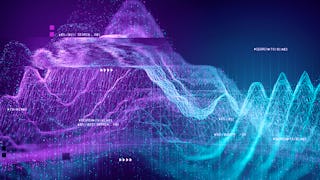One of the most important skills of successful data scientists and data analysts is the ability to tell a compelling story by visualizing data and findings in an approachable and stimulating way. In this course you will learn many ways to effectively visualize both small and large-scale data. You will be able to take data that at first glance has little meaning and present that data in a form that conveys insights.

Enjoy unlimited growth with a year of Coursera Plus for $199 (regularly $399). Save now.

Data Visualization with Python
This course is part of multiple programs.


Instructors: Saishruthi Swaminathan
348,339 already enrolled
Included with
(12,196 reviews)
Recommended experience
What you'll learn
Implement data visualization techniques and plots using Python libraries, such as Matplotlib, Seaborn, and Folium to tell a stimulating story
Create different types of charts and plots such as line, area, histograms, bar, pie, box, scatter, and bubble
Create advanced visualizations such as waffle charts, word clouds, regression plots, maps with markers, & choropleth maps
Generate interactive dashboards containing scatter, line, bar, bubble, pie, and sunburst charts using the Dash framework and Plotly library
Skills you'll gain
Details to know

Add to your LinkedIn profile
See how employees at top companies are mastering in-demand skills

Build your subject-matter expertise
- Learn new concepts from industry experts
- Gain a foundational understanding of a subject or tool
- Develop job-relevant skills with hands-on projects
- Earn a shareable career certificate

There are 5 modules in this course
Data visualization is a way of presenting complex data in a form that is graphical and easy to understand. When analyzing large volumes of data and making data-driven decisions, data visualization is crucial. In this module, you will learn about data visualization and some key best practices to follow when creating plots and visuals. You will discover the history and the architecture of Matplotlib. Furthermore, you will learn about basic plotting with Matplotlib and explore the dataset on Canadian immigration, which you will use during the course. Lastly, you will analyze data in a data frame and generate line plots using Matplotlib.
What's included
8 videos3 readings2 assignments2 app items1 plugin
Visualization tools play a crucial role in data analysis and communication. These are essential for extracting insights and presenting information in a concise manner to both technical and non-technical audiences. In this module, you will create a diverse range of plots using Matplotlib, the data visualization library. Throughout this module, you will learn about area plots, histograms, bar charts, pie charts, box plots, and scatter plots. You will also explore the process of creating these visualization tools using Matplotlib.
What's included
7 videos1 reading3 assignments3 app items2 plugins
Advanced visualization tools are sophisticated platforms that provide a wide range of advanced features and capabilities. These tools provide an extensive set of options that help create visually appealing and interactive visualizations. In this module, you will learn about waffle charts and word cloud including their application. You will explore Seaborn, a new visualization library in Python, and learn how to create regression plots using it. In addition, you will learn about folium, a data visualization library that visualizes geospatial data. Furthermore, you will explore the process of creating maps using Folium and superimposing them with markers to make them interesting. Finally, you will learn how to create a Choropleth map using Folium.
What's included
5 videos1 reading3 assignments2 app items1 plugin
Dashboards and interactive data applications are crucial tools for data visualization and analysis because they provide a consolidated view of key data and metrics in a visually appealing and understandable format. In this module, you will explore the benefits of dashboards and identify the different web-based dashboarding tools in Python. You will learn about Plotly and discover how to use Plotly graph objects and Plotly express to create charts. You will gain insight into Dash, an open-source user interface Python library, and its two components. Finally, you will gain a clear understanding of the callback function and determine how to connect core and HTML components using callback.
What's included
5 videos5 readings3 assignments4 app items2 plugins
The primary focus of this module is to practice the skills gained earlier in the course and then demonstrate those skills in your final assignment. For the final assignment you will analyze historical automobile sales data covering periods of recession and non-recession. You will bring your analysis to life using visualization techniques and then display the plots and graphs on dashboards. Finally, you will submit your assignment and Your submission will be auto-graded by AI using a tool called Mark. To wrap up the course you will take a final exam in the form of a timed quiz.
What's included
5 readings1 assignment1 peer review5 app items3 plugins
Earn a career certificate
Add this credential to your LinkedIn profile, resume, or CV. Share it on social media and in your performance review.
Instructors


Offered by
Explore more from Data Analysis
 Status: Free Trial
Status: Free TrialDuke University
 Status: Free Trial
Status: Free Trial Status: Free Trial
Status: Free Trial Status: Preview
Status: Preview
Why people choose Coursera for their career




Learner reviews
12,196 reviews
- 5 stars
68.83%
- 4 stars
19.25%
- 3 stars
6.26%
- 2 stars
2.87%
- 1 star
2.77%
Showing 3 of 12196
Reviewed on May 15, 2019
More in class projects similar to final assignment where we can challenge our knowledge as we are all remote and it takes time to communicate through the available coursera forums. Thank you.
Reviewed on Apr 30, 2020
Very challenging, yet that's what make it's rewarding. Even though the course only takes 3 weeks, its difficulty is on par with the longer previous course. I enjoyed every problems on it!
Reviewed on Aug 13, 2020
Great course, one of the best course to get hands-on learning for Data Visualization with Python. Particularly the lap exercise, it will make you think on every line of code you write. Excellent!!!

Open new doors with Coursera Plus
Unlimited access to 10,000+ world-class courses, hands-on projects, and job-ready certificate programs - all included in your subscription
Advance your career with an online degree
Earn a degree from world-class universities - 100% online
Join over 3,400 global companies that choose Coursera for Business
Upskill your employees to excel in the digital economy
Frequently asked questions
To access the course materials, assignments and to earn a Certificate, you will need to purchase the Certificate experience when you enroll in a course. You can try a Free Trial instead, or apply for Financial Aid. The course may offer 'Full Course, No Certificate' instead. This option lets you see all course materials, submit required assessments, and get a final grade. This also means that you will not be able to purchase a Certificate experience.
When you enroll in the course, you get access to all of the courses in the Certificate, and you earn a certificate when you complete the work. Your electronic Certificate will be added to your Accomplishments page - from there, you can print your Certificate or add it to your LinkedIn profile.
More questions
Financial aid available,
¹ Some assignments in this course are AI-graded. For these assignments, your data will be used in accordance with Coursera's Privacy Notice.

